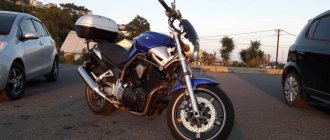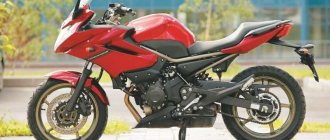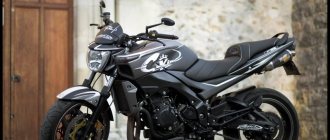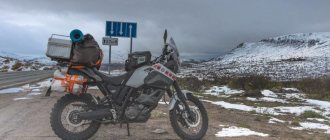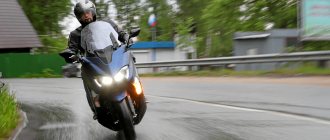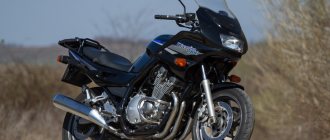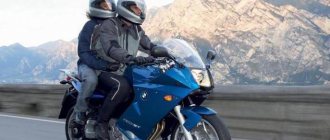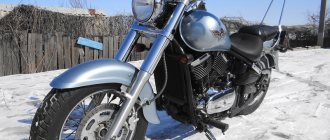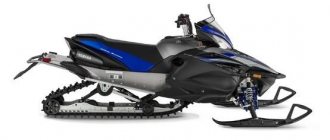Yamaha MT-03
Yes, the 2021 Yamaha MT-03 is not the first model under this name. The earlier version had a single-cylinder 660cc engine and looked like the ancestor of the entire MT series - a powerful naked with a fun engine, an upright riding position and a modern design.
Then the Yamaha MT-09, MT-07, MT-10 appeared (which in the States were branded FZ). These naked bikes marked a new era in Yamaha's history, and with the new MT-03, the Yamaha MT line-up has become even more complete - from small-capacity bikes to mighty street fighters.
The new Yamaha MT-03 is the smallest, lightest and most inexpensive motorcycle in the entire line. Apparently, it was prepared as an entry-level model, but for many it may not be the first bike. This is the era of small-capacity motorcycles, and manufacturers are incorporating technological innovations even into the youngest models - as evidenced by the stock ABS on the youngest MT. This model shares the engine and frame with the Yamaha YZF-R3, a very successful little sport, but it is quite difficult to confuse them with each other.
Design of Yamaha MT-03 2020
Design of Yamaha MT-03 2020
Despite sharing its roots with the Yamaha R3, the design and stance of the Yamaha MT-03 is quite different from its sibling. Here, Yamaha has applied the same visual style as the rest of the MT series motorcycles - even slightly exaggerating it. It's the first MT to feature ultra-thin running lights (slanted "eyes"), below which sits a single headlight. All lighting equipment is diode, which, of course, is another “expensive” feature of this model. Some people really like this design, while others think that the bike has
That face looks like he ate a lemon
The riding position on the Yamaha MT-03 is typical for the road, especially compared to the quite sporty riding position of the Yamaha R3. There is a different seat, crossbar and handlebars (39 mm higher and 19 mm closer to the rider), which provides a vertical seating position with the possibility of a slight tilt. The seat is quite spacious and allows you to slightly change your position during long rides. The steering wheel is quite high - if it were even higher, it would already resemble a motard. But even so, small naked bikes like this in the city are not much different from supermotos - due to their low weight and extreme agility. However, Yamaha constantly repeats that the design of the MT-03 resembles the appearance of a “big motorcycle”, and this is true - in the sense that the younger MT does not look like a toy, but, on the contrary, attracts the eye with its serious constitution.
For a 300, the Yamaha MT-03 has a fairly wide tank, and the paint job was directly taken from the older MTs. Moreover, it is united with the oldest MT-10 by side air ducts - most likely necessary so that beginners can show off to their friends. But more advanced riders, oddly enough, will find a lot of interesting things in this model, and will never feel like they are on a moped.
The Yamaha MT-03, like the R3, is assembled in Indonesia. It should be admitted that some little things - the gearbox foot, fasteners - look budget-friendly, but this is not news: we are considering a budget model. By the way, the decision to equip the stock version with ABS comes from the same story: it is simply cheaper for the manufacturer to produce one configuration option. And although ABS cannot be switched off here, judging by the forums, the usual trick with a fuse will work here too.
So, they took the R3, stripped it down a little, changed the components a little, not forgetting to add a couple of cheaper bolts, and got a new neck with ABS for good money. Was it worth it? Did it turn out balanced, and does it even make sense to choose MT over YZF? In short, the answer is YES!
Yamaha MT-03 on the road
We were given models in Red Fluo paint (the Yamaha MT-03 is also available in all black, but I prefer the red and gray combination). With my 175, I can stand freely with both feet, but a girl 10 cm shorter than me said that she mainly reaches with her toes, but given the weight of the motorcycle, this was not a problem for her. The seat height is 78 cm and is a good solution for a beginner bike.
We start moving with ease: the clutch lever is easily squeezed, gears are switched in a clear Yamah manner. The character of the engine is no different from the R3. If you're not yet familiar with the R3, I'll try to describe it: it's easy to spin from the bottom, fairly peppy at the top, and quite forgiving when choosing the wrong gear. Even more than that, it actually encourages you to shift less - and this is surprising for a 321 cc twin. True, this pair of horses has approximately the same number as the 660 cc single-pot “original” MT-03 - 41 pieces. The thrust, however, is less - 29.8 Nm. And as for me, this engine is ideal - at least for this motorcycle.
Landing with almost straight arms and only slightly back legs, straight back if I sit closer to the tank. I'm 175 and my knees almost completely blocked the ridges in the tank, so if you're taller, try the bike on the show floor first. The seat turned out to be very comfortable for a long trip. Leaving the city, I appreciated the excellent handling of the bike, ideal for riding on bad asphalt with holes and bumps. And then I began to deliberately point it at holes and bumps to evaluate how the suspension would cope with them. According to Yamaha, the MT-03 fork is softer than on the R3, and in my opinion it is optimal for my 80 kg plus gear. And on too big bumps you can always stand up on the pegs.
As I made my way towards the highway, I thought the Yamaha MT-03 was a great city bike. It's narrow, has a soft grip and weighs 169kg when loaded. Its brakes are optimal for low speeds without being overly sensitive. The rear brake is perhaps too delicate for me, but it’s probably good for a beginner, and you can always install stronger pads. I have not tested stock ABS.
And finally, we left the city. I can finally try third gear! On the road, the Yamaha MT-03 handles superbly and completely surpasses my expectations of a 300cc naked bike. The MT has the same transmission as the R3, and the maximum speed on it is available in fourth, while fifth and sixth are essentially needed to save fuel and reduce revs at highway speeds. My feelings can be expressed this way:
The Yamaha MT-03 is at ease on the highway - unlike most 300 cc machines. I would install a windshield if I had to drive for several hours at a time. But on our trip there was no need for this.
On the serpentine
But the main part of our trip began when we turned off the highway onto a mountain road. I recommend to all! Here the two top gears are no longer needed, and I rode enjoying complete control of the engine in corners.
It's fun to come out of a hairpin almost at full throttle. After 11,500 rpm there's not much to expect from 300+ cc, but the Yamaha MT-03 handles like a grown-up. Already from 4000, excellent traction appears, and if you generally like small-capacity twins, you will like the MT-03 without a doubt. Keep it in the good timing zone and don't be afraid to turn, as the song says. The seating position, light weight and comfortable steering wheel allow you to ride it dynamically, but without much risk.
The Yamaha MT-03 wheels are wrapped in the same Dunlop Sportmax GPR 300 as the R3 and are excellent stock rubber. And most importantly, you definitely have enough time to study it thoroughly, because it is very wear-resistant - you can even master the burnout for Instagram. My rear wheel only swerved once, and that was only because I (foolishly) took the wrong line and drove through the mud on the exit of a corner. On clean asphalt, the Sportmax instantly grabbed hold. Smooth and precise throttle allows precise control of traction in unfamiliar corners. The informative front brake provides competent trail breaking, and the single front disc is more than enough here.
The hills were interspersed with valleys in between, and I periodically opened the throttle all the way, remembering my youth and the old motorcycles I learned to ride. I sometimes miss this feeling on larger vehicles: when you turn up the gas on the road without fearing for your life or your license, you immediately get the feeling that you are in the right place and on the right motorcycle.
While driving, the engine can be felt by the ears and the rest of the body, without much need for tidying. The LCD display, the same as on the R3, is somewhere in the field of view and, if necessary, will remind you of the gear number or show the speed of movement. A quick glance at it is enough to find out everything that interests me. An interesting feature - the oil life scale - allows beginners to plan maintenance in advance and extend the life of the engine. If you asked me what needs to be changed on the display, I would advise making the gear number larger and higher.
Hello! I’ve been collecting my thoughts for a long time, but only now, on vacation, I finally have time to share my impressions of the motorcycle. There are a lot of reviews of MT-03 on the Internet. And here, at BP, many issues have already been discussed several times. Therefore, I will try to avoid repetitions, but combine them in one place. Google produces a lot of official and commercial reviews. You can also read, for example, a review of the MT-03 on a power supply: Review of the Yamaha MT-03 However, such promotional articles usually have a tendentious nature, are replete with all sorts of niceties and essentially have marketing purposes. Therefore, it is much more useful to receive information about motorcycles directly from the owners, as well as from discussion posts. By the way, I became acquainted with the power supply through the review of the MT-03 from 143145. Here it is: Yamaha MT-03. First post about the first motorcycle. Then there was the second one: Experience using the Yamaha MT-03 So thank you, Alexey, doubly! In these same reviews, many issues were discussed in subsequent comments. And I will draw some details for the current discussion from there.
Appearance As you know, “taste and color...”, but in my opinion it is really beautiful.
As ualinker wrote in his explanation of the MT-03: “How beautiful it is in real life!” :))) Especially on the right side thanks to the rear shock absorber placed outside.
I have a 2006 model, the swingarm, fork legs are silver, the rear shock absorber spring is yellow. Since 2007, Yamaha have changed the color schemes. They began to paint the spring white and red, and the pendulum and feathers black. It's a shame, the bike started to look worse. Became kind of boring...
Design features MT-03 looks quite compact and in fact it is. Short wheelbase (1420 mm), with a small forward tilt angle of the fork. She seems to be tucked under herself. Due to this, as well as the large turn of the steering wheel, you can turn around almost on the spot. And in standing traffic jams, it is very easy to climb from corridor to corridor. Taxiing is also made easier by a weight distribution of 52/48% in favor of the front end. The seat is slightly forward, and the footpegs are rearward - a kind of enduristic landing. The saddle height is 805 mm, but it doesn’t seem high to me. I can touch the ground with both feet, although I very rarely do this at stops: I practically never take my left foot off the step (after braking I only lower my right one). Due to the increased saddle height, the motorcycle has a high ground clearance of 200 mm, probably the highest among street bikes. So, if desired, it can easily climb onto any edge and back. The tank is made of plastic. There is no downside for those who prefer magnetic tankbags... But there are solutions like tank-locks, which can be found, for example, on Luis. I don't use it yet. The tank, by the way, is 15 liters, which, depending on the driving style, can last from about 180 to 270 km.
Ergonomics and comfort The seating position is almost straight, which is very convenient in the city, but causes obvious inconvenience when driving on the highway above 110-120, since I have no wind protection. The MT-03 offers short windshields, but I don’t know if they are useful. In any case, I won't bet. This would obviously break his naked style. There were complaints (vasilio) about the slippery seat and constant fidgeting back and forth when accelerating/braking. To be honest, I didn't notice. I usually sit close to the tank. The control levers are standard, like everyone else.
There is an emergency button, I use it often.
The steering wheel does not seem to be original to me, it is chrome and wider than the standard one (85cm). It’s comfortable for me, I’ve gotten used to wide ones since cross-country. In addition, a wider steering wheel gives better control over road irregularities and is a kind of limiter for the intention to climb into extremely narrow corridors.
I got the grips from Domino, I highly recommend them: a little thinner than the standard ones; soft and pleasant to the touch. Under these thinner grips there are also other steering weights.
A huge minus is that there is practically no usable space under the seat. As conceived by the designers, the spare parts fit into the small space under the passenger seat.
I only have a piece of rag there, I don’t carry anything else. At the same time, there is simply a huge (almost 6 liters) air filter housing, which occupies almost the entire space under the driver’s seat. But you can't steal anything there. The battery is hidden under the tank. I don't know if this is good or bad. I've never climbed there before.
The brakes are simply excellent for such a sharp and high-torque engine. Especially from the front. Two disks. Lever travel is minimal. Soft, grabs instantly. Reinforced hoses.
The rear one is no worse. Although vasilio complained about its low efficiency, his problem was solved by installing normal pads. I installed SBS, synthetic. They grip perfectly:
Engine and gearbox 660 cm3, single-barrel. What else can I say? Its 45 hp. on the shaft and, naturally, less on the wheel compensates for the good torque. Isn't that what the city needs, huh? The main complaint, including mine, is vibration. Oh, those vibrations , but basically I’m used to it. But you should always carefully monitor the tightening of bolts and nuts. Already lost several fasteners and even one slider on the step. Instead, they carved it out of bronze for me. I changed both:
What else can I say? Its 45 hp. on the shaft and, naturally, less on the wheel compensates for the good torque. Isn't that what the city needs, huh? The main complaint, including mine, is vibration. Oh, those vibrations , but basically I’m used to it. But you should always carefully monitor the tightening of bolts and nuts. Already lost several fasteners and even one slider on the step. Instead, they carved it out of bronze for me. I changed both:
But this unique sound even with the stock muffler and sexy pops when closing the gas! By the way, another feature is excellent engine braking. Out of habit, when letting off the gas in lower gears, I often nodded off, but it really helps when braking the motorcycle.
pops when closing the gas! By the way, another feature is excellent engine braking. Out of habit, when letting off the gas in lower gears, I often nodded off, but it really helps when braking the motorcycle.
Box. Loud like all Yamahas. Such a loud, juicy click, similar to the click of a tongue. But if you get used to it and shift smoothly, matching the engine and wheel speeds, you won’t hear the shift at all. Since the gear ratios are very close, you can shift using the principle described above, squeezing the clutch literally a quarter of the handle stroke. Or even without it at all. I tried it, it works. Again, I don’t agree with vasilio about the muffler. Nothing particularly rusts for me. There is some superficial yellowishness, but nothing more.
Loud like all Yamahas. Such a loud, juicy click, similar to the click of a tongue. But if you get used to it and shift smoothly, matching the engine and wheel speeds, you won’t hear the shift at all. Since the gear ratios are very close, you can shift using the principle described above, squeezing the clutch literally a quarter of the handle stroke. Or even without it at all. I tried it, it works. Again, I don’t agree with vasilio about the muffler. Nothing particularly rusts for me. There is some superficial yellowishness, but nothing more.
The muffler seems to be made of stainless steel (!). One day I had to take it off because... decor fastenings broke off. overlays. So my friend welded it in front of me, the metal is not magnetic, he welded it with stainless steel wire. And I didn’t notice any rust on the body at all. We welded these “ears”, went over questionable seams and microcracks. There is no catalyst inside the can! Now I can’t find it, but on one bourgeois forum I saw a photo of an opened muffler from an MT-03. There are simply 2 chambers inside, which are connected by perforated tubes. That's all. In essence it is only a resonator. By the way, I can see something boiled inside (pipe?) and it’s ringing a little. I would like to install something more impressive, but I’m not ready to fork out 500+ euros yet. By the way. When washing, it is very useful to cover the mufflers with caps from plastic bottles - they do just that. Water won't get in.
How does he drive? Much has already been written about this. The main feature: excellent traction from the bottom + short passes. Drag start is a champion. You have to click constantly. Those who are used to sports, where you can go 100+ on the 1st stage, and in the city the 1st, 2nd, 3rd on holidays, will feel uncomfortable.
The main feature: excellent traction from the bottom + short passes. Drag start is a champion. You have to click constantly. Those who are used to sports, where you can go 100+ on the 1st stage, and in the city the 1st, 2nd, 3rd on holidays, will feel uncomfortable. Here we need to work; the 5th sticks in just 200 meters from the start. And also back. With a cross-country background, I like this. But you don’t have to worry too much about the choice: it works equally well in 3rd or 5th. Between the rows, 1st and 2nd hold confidently at low speeds. Maximum speed?.. I didn’t set such a goal for myself. Tried it on the highway. 145 I can still somehow drive, then I need to either lie down on the tank or pray, because it’s difficult to hold it. Wind protection is missing as a class. But when traveling to the country, cruising 125-130s are quite comfortable. There were opinions (Alexey) to install a smaller sprocket on the rear by a couple of teeth to increase the maximum speed. I even tried with a friend to ride an MT-shke with such changes, but other than the weakness of the engine, I didn’t feel anything useful. But the guy was bragging that he got 177 out of him. To me, the idea isn't worth it. The bike is not intended for monotonous long-distance travel. Although there are examples of using it as a touring motorcycle (for example, here is the Blog of one Pole). Still, his element is the city.
Here we need to work; the 5th sticks in just 200 meters from the start. And also back. With a cross-country background, I like this. But you don’t have to worry too much about the choice: it works equally well in 3rd or 5th. Between the rows, 1st and 2nd hold confidently at low speeds. Maximum speed?.. I didn’t set such a goal for myself. Tried it on the highway. 145 I can still somehow drive, then I need to either lie down on the tank or pray, because it’s difficult to hold it. Wind protection is missing as a class. But when traveling to the country, cruising 125-130s are quite comfortable. There were opinions (Alexey) to install a smaller sprocket on the rear by a couple of teeth to increase the maximum speed. I even tried with a friend to ride an MT-shke with such changes, but other than the weakness of the engine, I didn’t feel anything useful. But the guy was bragging that he got 177 out of him. To me, the idea isn't worth it. The bike is not intended for monotonous long-distance travel. Although there are examples of using it as a touring motorcycle (for example, here is the Blog of one Pole). Still, his element is the city.
Availability of spare parts With consumables Approx. But frankly speaking, there is a problem with the rest. No, of course, everything can be found abroad or ordered from officials, but you will have to wait. Often for a long time. There are practically no MT-03s at disassembly sites. The motorcycle is quite rare and no one wants to carry it. The same goes for defense. I scoured a bunch of internet looking for arcs and crashpads. None of the regular and alternative ones inspired respect or trust. I've been toying with the idea of making arches myself, but the question is still open. Due to their absence, progress in drifting and other tricks has so far stalled. It's a pity to drop...
Operation Since the date of purchase the following has been done: 1. Replacement of the tail section with the original one. I got it with a shortened tail, but it was made in Italian, sloppy and artisanal. Luckily, during disassembly, an 03 turned up and I was able to buy the entire rear assembly for an inexpensive price. 2. Replacement of the rear sprocket mounting couplings (there was a decent amount of play). 3.Replacement of tires. I spent a long time deciding what to choose and settled on this one:
In my opinion, such a tread should better handle the quality of our asphalt, occasional sand and puddles. So far I'm happy. 4.Replacement of rear pads. SBS (Denmark) 5. Consumables. Spark plug, filter, oil. I wrote about it separately: Choosing oil 6. Repairing the instrument panel 7. I pasted yellow stickers on the rims. Seems good! 8. Replaced the turn signals and mirrors 9. Replaced the clutch and brake levers. No breakdowns or failures have been observed so far.
That's all I wanted to say. Ready to answer all questions!

